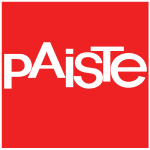Paiste
This article has multiple issues.Please helpimprove itor discuss these issues on thetalk page.(Learn how and when to remove these template messages)
|
 | |
| Company type | Private(Aktiengesellschaft/AG)[1] |
|---|---|
| Industry | Musical instruments |
| Founded | 1906inSaint Petersburg,Russian Empire |
| Headquarters | , |
Number of locations | 5 |
Key people | Erik Paiste, CEO and president of thesupervisory board |
| Products | Cymbals,gongs,crotales,cowbells |
| Subsidiaries |
|
| Website | paiste.com |
Paiste(English pronunciation:/ˈpaɪsti/PY-stee,Estonian pronunciation:[ˈpɑiste]) is aSwissmusical instrumentmanufacturing company. It is the world's third largest manufacturer ofcymbals,gongs,and metalpercussion.[citation needed]Paisteis aFinnishandEstonianword that means "shine".[citation needed]
Apart from cymbals and gongs, Paiste has also manufactured other percussion instruments, includingcrotal bells,finger cymbals,andcowbells,which were later discontinued.
History
[edit]The first Paiste cymbals were produced in 1906 byEstonianmusician Toomas Paiste in his instrument repair shop inSaint Petersburg,Russian Empire.Toomas had served in theRussian Imperial Guardand retired in 1901 to open a music shop and publishing business.[2]
The cymbal-making aspect of the business expanded with the passing years, despite the disruption of several moves necessitated by war:[3]first toTallinn,Estonia, in 1917, where Toomas' son Michail M. Paiste decided to concentrate on cymbal production and export.[3]In 1940, the family and the cymbal-making operation moved toPoland,where they continued under extremely difficult conditions, and in 1945 toGermany.[3]Finally, in 1957, a new headquarters and production facility was established inSwitzerland.[3]The business was continued by Michail's sons, Robert and Toomas (born Kurt), with both the Swiss and German operations as the main manufacturing centres. Since 2003, the company has been headed by Toomas' son, Erik.[2]Robert Paiste died in 2016, aged 84.[4]
Innovations
[edit]Paiste has developed several innovations to cymbal design and manufacture. Among these are:


- TheFlat Ride:Aride cymbalwithout a cup or bell. Originally designated as Space Sound in the Formula 602 line. Designed withJoe Morello.Introduced in the 1960s.
- Thesplash cymbal:Widely used forjazz musicin the 1920s and 30s, the traditional splash cymbal was not seen for many years in mainstream music untilThe Police’s drummerStewart Copelandbrought it back to prominence in the early 80s. Thanks to a toy cymbal he found in a trip inAsiaand which he brought to Paiste, heavier splash cymbals, more suited for harder styles of drumming, were soon available and started being heavily commercialized. Then alongsideManu Katchéspread the use of this type of cymbal.
- The Sound Edge Hi-Hat: Introduced in 1967. To prevent airlock, the bottom cymbal of thehi-hatpair has ripples along the edge. Also applied tohand cymbalsets.
- The use of B8 bronze as acymbal alloy:Referred to by Paiste as "CuSn8" alloy or "2002 bronze". First introduced with the Stambul 65 series in 1965. Gained general acceptance with the Giant Beat and the 2002 series. Paiste was for a time the only major cymbal company to use the B8 alloy for its high-end lines, althoughMeinlhas recently[when?]introduced a line of high-end cast B8 bronze cymbals as well.ZildjianandSabianuse this alloy primarily for entry-level lines, choosing instead to use bell bronze for high-end products.
- 'Flat' bells: With the introduction of the Sound Creation Short Crash in late 1977, Paiste was the first to make use of a flattened bell design. Used today with the Crystal Hi-Hats and Crashes of the Signature series.
- Unlathed cymbals: Introduced in 1980 as the RUDE series. Made from the B8 alloy, unlathed cymbals were marketed towards louder music styles aspunkandheavy metal.
- Inverted bellon China cymbal: Introduced in 1983 as the 2002 NOVO china type. Makes it easier to play ride and crash on aChina cymbal.
- Coloured cymbals: Introduced in 1984.
- Proprietary Signature Bronze: A patentedcymbal alloyintroduced in 1989, with the Signature line. According to the patent, this alloy consists ofphosphor bronzewith a 14.7% to 15.1% tin content by weight. It has been claimed by Paiste to be the first bronze alloy specifically developed for cymbals.
- Sonic Texture Formula: Introduced in 2001 with the Innovations series. A patentedlathingtechnique to get a more complex sounding cymbal.[citation needed]
Many of these innovations were used by other manufacturers when the applicable patents expired. For example, almost all the larger modern cymbal companies offer a flat ride cymbal and an alternative to the Sound Edge Hi-Hat.
Notable artists
[edit]- Bill BrufordofYes/King Crimson/Earthworks
- Josh FreeseofFoo Fighters
- Josh DevineofOne Direction
- Nicko McBrainofIron Maiden
- John BonhamofLed Zeppelin
- Stewart CopelandofThe Police
- Larry Mullen Jr.ofU2
- Charlie BenanteofAnthrax
- Dave LombardoofTestament/Suicidal Tendencies/Slayer
- Phil RuddofAC/DC
- Abe Laboriel Jr.ofPaul McCartney
- Tommy AldridgeofWhitesnake
- Joey JordisonofSlipknot
- Ian PaiceofDeep Purple
- Paul BostaphofSlayer
- Tico TorresofBon Jovi
- Mikkey DeeofScorpions
- Danny CareyofTool
- Nick MasonofPink Floyd
- Alex Van HalenofVan Halen
- Scott TravisofJudas Priest
- Chad SmithofRed Hot Chili Peppers
- Frank BeardofZZ Top
- Simon KirkeofBad Company
- Bruce GaryofThe Knack
- Jeff PorcaroofToto
- Carl PalmerofEmerson, Lake and Palmer
- Matt FlynnofMaroon 5
- Daniel Wagner ofGreta Van Fleet
- Thomas Götz ofBeatsteaks
- Eloy CasagrandeofSlipknot
- John DolmayanofSystem of a Down
- InfernoofBehemoth
- Brad WilkofRage Against the Machine
- Pierre Favre
- Jake Cochran ofIlliterate Light
- Gonzo Sandoval ofArmored Saint
Patents
[edit]References
[edit]- ^Entry at the Swiss Official Gazette of Commerce, SOGC
- ^abHistoryon Paiste website, 07 Nov 2023
- ^abcdLudwig, William Frederick (2001).The Making of a Drum Company: The Autobiography of William F. Ludwig II.Hal Leonard Corporation.ISBN978-1-888408-05-8.
- ^"In Memory of Robert Paiste"on Paiste website, retrieved 8 November 2020
